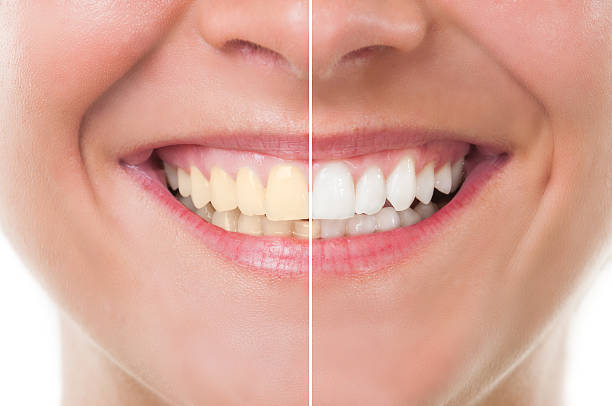teeth whitening
- Home
- Teeth Whitening

Tooth whitening or tooth bleaching is the process of lightening the color of human teeth. Whitening is often desirable when teeth become yellowed over time for a number of reasons, and can be achieved by changing the intrinsic or extrinsic color of the tooth enamel. The chemical degradation of the chromogens within or on the tooth is termed as bleaching.
Hydrogen peroxide is the active ingredient most commonly used in whitening products and is delivered as either hydrogen peroxide or carbamide peroxide. Hydrogen peroxide is analogous to carbamide peroxide as it is released when the stable complex is in contact with water.
Teeth whitening products and other at-home options
You can purchase over-the-counter (OTC) whitening products to help with stained teeth. Unlike products administered by a dentist, these products have no carbamide peroxide, or, much less than the products dentists use. This means that if your teeth are intrinsically discolored, OTC teeth whiteners may not work as effectively or may take longer to whiten your teeth. Some OTC products have the American Dental Association’s Seal of Acceptance. Not all products have this seal, and some products without it are still fine to use, but this seal is meant to give you more confidence to make buying decisions and to ensure what you’re using is safe. Always follow the manufacturer’s instructions when using a product.
Whitening toothpastes
Whitening toothpastes don’t use carbamide peroxide. Rather, these toothpastes target the surface of your teeth with a variety of substances, including abrasives and the chemical blue covarine. It may take time for whitening toothpastes to work, but those with blue covarine may be effective after just one brush because the chemical makes your teeth appear whiter. Whitening strips
You can also purchase over-the-counter whitening strips for your teeth. These contain a smaller amount of hydrogen peroxide than professional products. You apply them one or two times a day to your teeth for a set period of time as indicated by the manufacturer.
A variety of whitening strip products are available, each at varying concentrations of bleaching agent.
Activated charcoal and other home-based methods
You may be curious about using homemade methods to whiten teeth. Activated charcoal is one such treatment. These methods are not scientifically proven to whiten teeth and should be discussed with a dentist before trying them. You may damage your teeth if you use these methods without first consulting a dentist.
Side effects and other considerations
1.Teeth sensitivity
Teeth sensitivity is one of the most commonly reported side effects of teeth whitening. This can occur if the patient has weakened enamel or if the whitening is not properly administered. In-office whitening is the best way to minimize the risk of sensitivity during and after treatment as the dental professional can apply the bleaching agent in the safest way possible. Dentists often recommend certain treatments before whitening, if necessary, to reduce the risk of sensitivity. For example, dentists may recommend a patient with dental cavities receive dental fillings before the whitening procedure.
2.Gum irritation
In-office whitening involves isolating the teeth from the gums using a dental dam. This significantly reduces the risk of gum irritation. However, gum irritation can occur if the gums are not properly isolated or if the take-home or store-bought kit is not properly applied. Most patients do not experience any issues with gum irritation, particularly when it is performed in the office and administered by a dental professional.
3.Ineffective results
It is important to have realistic expectations as to what to expect from treatment. Teeth whitening can remove most minor stains, but it is not effective in treating more severe stains, known as “intrinsic stains.” The dentist can show you on a shade guide the type of results you can expect and go over your alternative options if the ideal results cannot be achieved through teeth whitening.


